Homemade German Bratwurst
This post may contain affiliate links. See my disclosure policy.
Experience the delicious taste of Germany through this thoroughly authentic homemade bratwurst recipe! Make a double batch, freeze them, and you can conveniently grab and grill a bratwurst any time the craving hits you!

German Bratwurst
This is a special day because today is the day I’m going to show you how to make bratwurst. And not just any bratwurst. I’m going to share with you my recipe for authentic homemade German bratwurst! With the first bite you’ll immediately recognize that “German flavor” that you know and love from time spent in Germany eating Bratwurst from the German fast food stands. Whether enjoyed whole and served with mustard on a crusty roll or sliced and served as Currywurst, there is nothing quite like a real German Bratwurst!
Boasting over 1500 varieties of Wurst, Germany has long been the world’s Sausage Capital. One such Wurst, the Bratwurst, claims around 40 different varieties itself and has a proud heritage going back hundreds of years where it was first officially documented in 1313. Yes, the savory Bratwurst is synonymous with Germany itself and has remained a cultural icon for centuries.
The term Bratwurst is derived from the Old German word Brät (meaning “chopped” meat) as well as the more contemporary verb braten (meaning “to fry”). While some kinds of sausages are eaten poached, the Bratwurst is always grilled or pan-fried to get the skins nice and crispy. However, you can first poach before grilling/frying to infuse them with more flavor (like poaching them in beer) or if you simply want to ensure that they’re evenly cooked through before grilling or frying them.
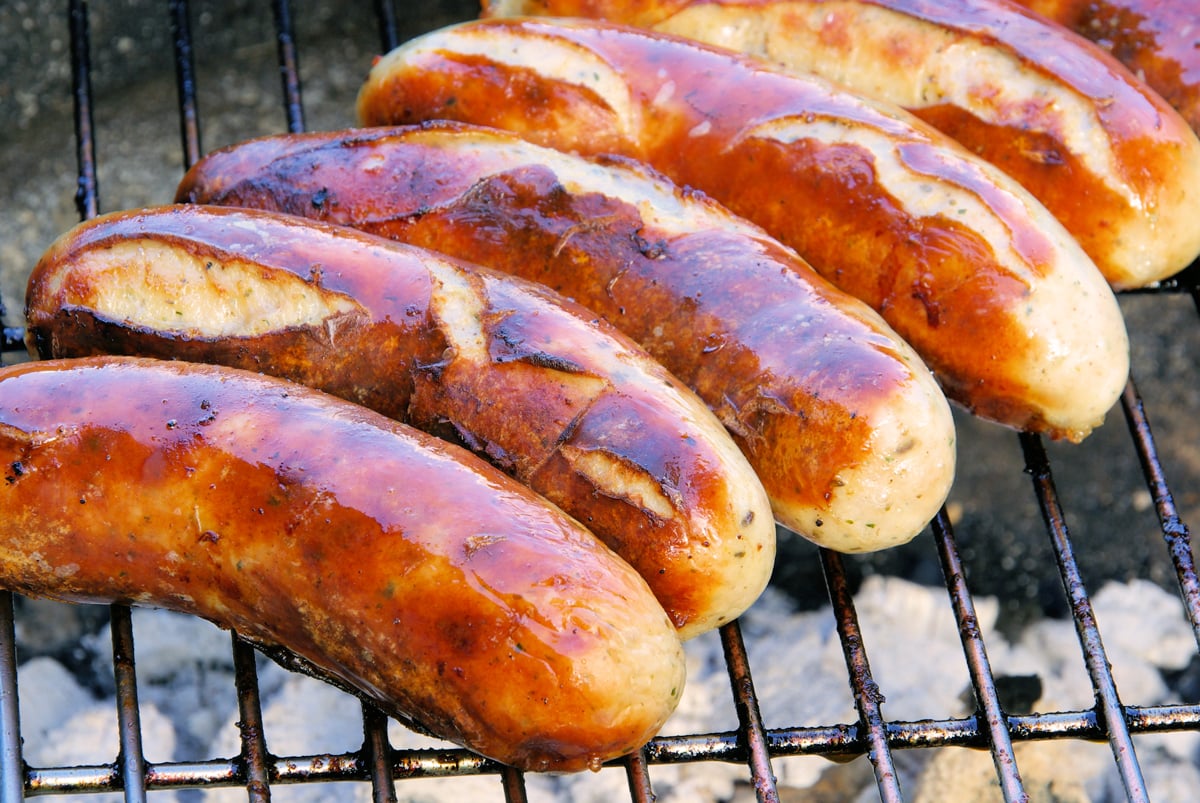
Different regions of Germany make their Bratwursts a little differently and the spices and herbs will vary as well the kind of meat used. Some varieties use pork only, some use a combination of pork and veal, some use mostly veal with a little pork, while others use pork with a little beef.
Some of the most popular regional varieties include the Fränkische Bratwurst, Nürnberger Rostbratwurst, Thüringer Bratwurst (very long and thin, my favorite as a kid) and Rote Wurst (from the Swabia region where I grew up and made with the addition of bacon, yum!).
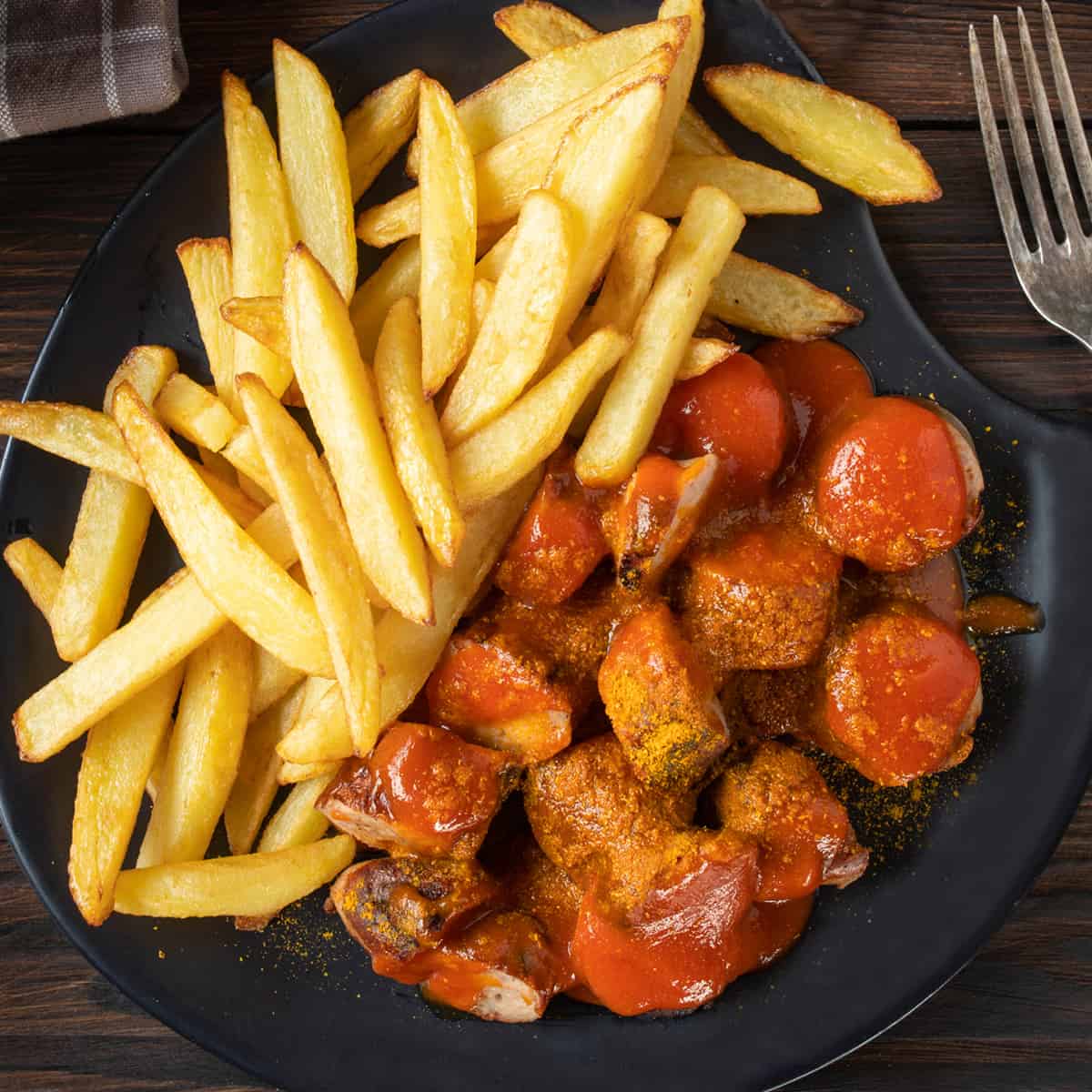
Sausage Making Equipment
For making sausages you’ll need a meat grinder and a sausage stuffer. Years ago I tried using the Kitchenaid attachments for both of these and as any experienced sausage maker will tell you, they’re downright frustrating if you want to make any more than 2 or 3 sausages. If making sausages is something you’re interested in doing I strongly recommend getting some good equipment that won’t leave you frustrated, vowing never to make sausages again, and that won’t jeopardize the quality of your sausages.
In choosing our sausage-making equipment, my husband and I did a lot of research and chose the items that were great quality without having to pay a fortune.
Meat Grinder
I use the STX International Turbo Force Electric Meat Grinder. With 3000 watts, 3 speeds and a 3-year warranty, it has high reviews and comes top recommended by most review sites as the best bang for the buck.
Sausage Stuffer
I also use the Super Deal Heavy Duty 5L Vertical Sausage Stuffer and have been very happy with it. We carefully researched the sausage stuffers on the market and chose this one specifically because of it’s large capacity and 100% metal construction (no plastic parts = not breakable) and it’s also easy to clean.
Hog Casings
I only use casings from The Sausage Maker. They are sourced from North American hogs whereas other brands source them from China. I use and recommend these hog casings from The Sausage Maker.
Sausage Making Books
Once you get the basics of sausage-making down you can experiment with your own flavors and combinations which is what I love to do. But having a few good books with sound instructions for technique and reliable recipes are a must. I have combed through many books on charcuterie and sausage-making over the past few years and these ones continue to be my favorites:
Great Sausage Recipes and Meat Curing by Kutas is a classic and one of the first comprehensive books written on the subject. It’s a no-nonsense, straight-forward book packed full of recipes. Charcuterie: The Craft of Salting, Smoking and Curing by Ruhlman has likewise been a very popular book. The current edition is revised and updated. I have the previous edition and there are inaccuracies and errors in it that the newest edition has reportedly fixed, but I still hear complaints about it. Nevertheless, it’s a great book with some great recipes. Olympia Provisions: Cured Meats and Tales from an American Charcuterie is both a fun and inspiring read. The author, Elias Cairo, is the founder of Olympia Provisions in Portland, Oregon and owns several restaurants and butcher shops there. This book features several of his most popular recipes.
The final two books are both written by Stanley & Adam Marianski: The Art of Making Fermented Sausages and Home Production of Quality Meats and Sausages. While these are a very dry read and don’t have the beautiful photography or inspirational stories the other books have, I consider these indispensable to anyone who is serious about learning the art of charcuterie and sausage-making. Consider them the most comprehensive “how-to” manuals on the market. And if you are planning on dabbling in dry-cured meats, The Art of Making Fermented Sausages is a MUST.
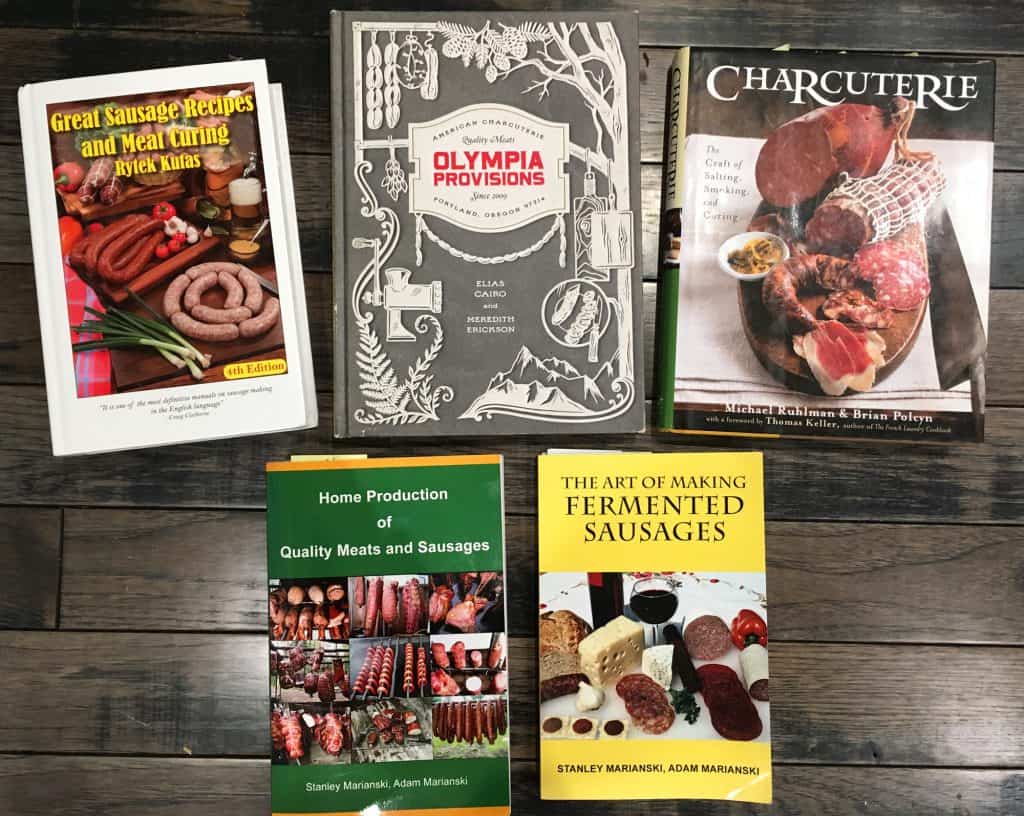
German Bratwurst Recipe
Then let’s get started!
Dice the pork and fat and freeze them for about 45 minutes to get them to a temperature of 32 degrees F (0 celsius).
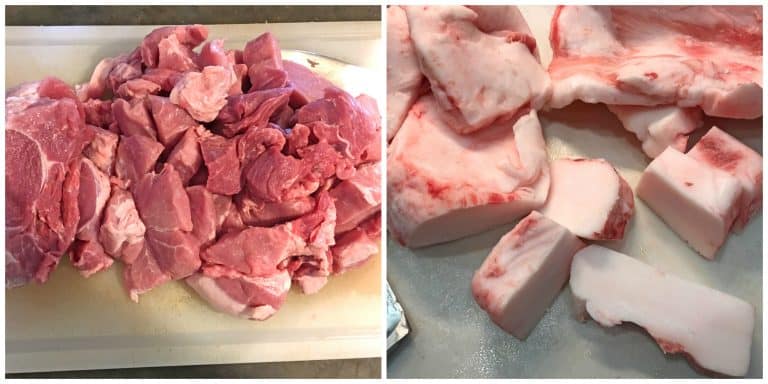
Combine the pork, fat and crushed ice in a bowl and then, working quickly, grind the mixture through a 1/4 inch (6mm) die. Preferably grind the meat mixture into a bowl set atop an ice bath to keep the meat cold. Grind half of the ground mixture a second time. It is imperative that the meat be at a constant cold temperature so that the fat doesn’t get too soft. You should be able to see clear definition between the lean meat the specks of fat in the ground mixture.
Chill the meat in the refrigerator while you assemble the spice mixture.
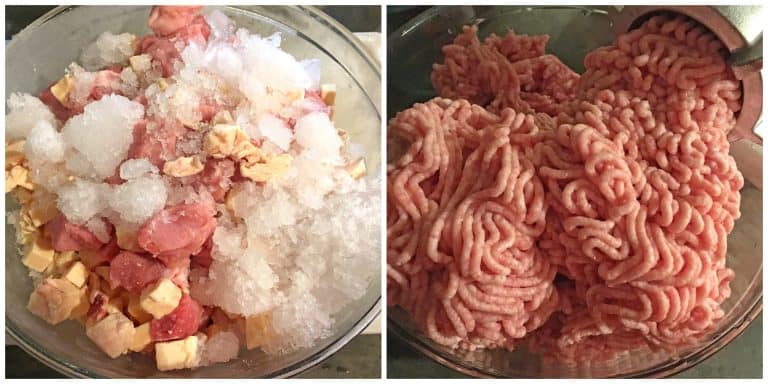
In a small bowl combine all the spices.
Remove the ground meat from the fridge and place it on the stand mixer fitted with a paddle attachment. Add the spice mix and dry milk powder.
Mix the meat mixture with the paddle for 3-4 minutes until threads begin to appear in the meat: If you take a clump of meat and pull it apart with your fingers you will see tiny threads pulling apart. When you see this your meat is ready. If the meat mixture is too dry and stiff, add a little ice water. **If the meat mixture is too dry and stiff, add a little
ice water. You want a soft/smooth mixture that will easily go into the casings.
*This is also the time to taste your sausage mixture so you can adjust the seasonings if needed. To do this, take a bit of the meat mixture, fry it up in a pan, taste it and adjust the seasonings if needed.
Place the meat mixture back in the refrigerator while you prepare the casings.
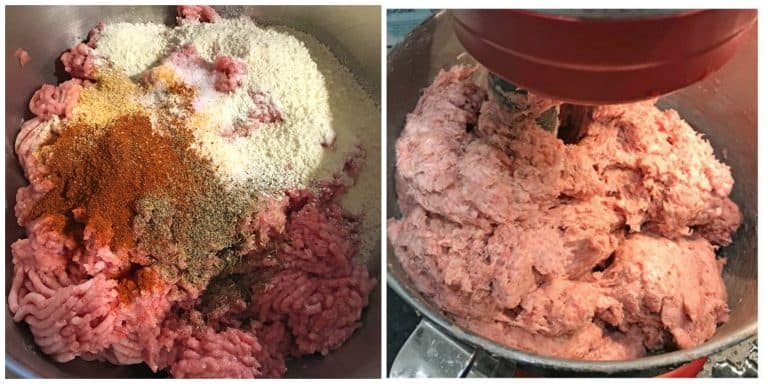
Thread the sausage stuffer with the prepared hog casings, fill the sausage stuffer with the meat mixture, and stuff the casings being careful to avoid air gaps while also being careful to not over-stuff the casings.
Twist the sausages into links. Use a sausage pricker to prick any air bubbles out of the links.
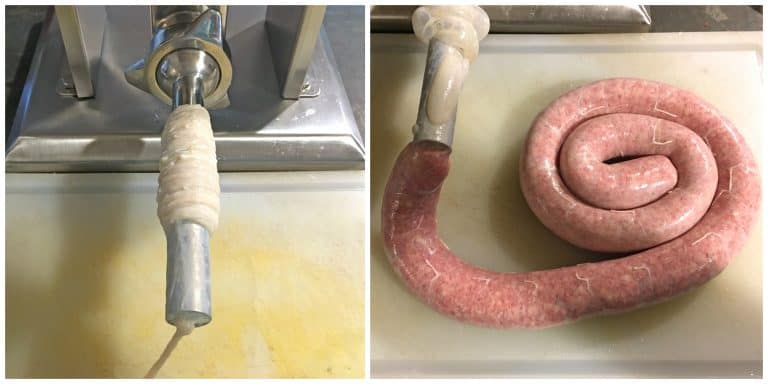
Your Bratwursts are finished. For best results chill the sausages overnight.
To prepare them, you can gently poach them in lightly salted water (optional to ensure they’re evenly cooked or you can poach them in beer to infuse them with more flavor) and then fry or grill them to get their skins nice and crispy. Once poached they will keep in the fridge, tightly wrapped, for up to a week.
You can either freeze the Bratwursts raw prior to poaching (then thaw, poach, fry/grill) or freeze them once they’re poached.
Whether pan-fried or grilled, you’re going to love these Bratwursts!
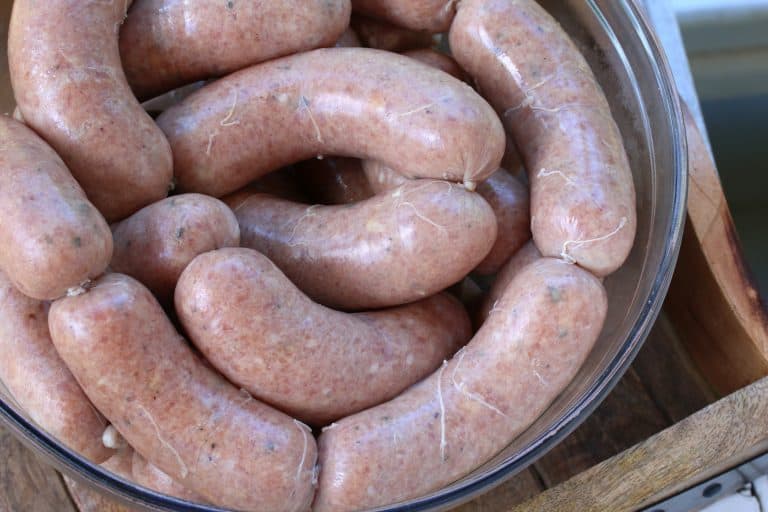
What Do You Serve with Bratwurst?
The most popular accompaniments include a crusty roll cut open and slathered with German mustard or served with sauerkraut, French fries, or potato salad (like this Authentic German Potato Salad).
The Bratwurst is also popularly transformed into the famous Currywurst by slicing the sausages and serving it topped with Curry Ketchup (see our recipe for Currywurst).

For more delicious adventures in homemade charcuterie be sure to try my:
- Smoked Ham Hocks
- Smoked Ham
- Smoked Cheddar Sausages
- Breakfast Sausage
- Bangers
- Mexican Chorizo
- Italian Capicola
- Gravlax
- How to Make Bacon
Save This Recipe

Homemade German Bratwurst
Ingredients
- 2 1/2 pounds boneless pork shoulder (can substitute part veal if desired) , cut into 1/2 inch pieces and put in freezer for 45 minutes prior to grinding
- 12 ounces pork back fat , cut into 1/2 inch chunks and put in freezer for 45 minutes prior to grinding
- 2 cups crushed ice
- For the Spice Mixture:
- 1 1/2 tablespoons salt
- 1/4 cup dried milk powder
- 1 1/2 teaspoons freshly ground white pepper
- 3/4 teaspoon freshly ground black pepper
- 1 teaspoon ground mace (can substitute nutmeg but strongly recommend mace for traditional German flavor)
- 1 teaspoon ground ginger
- 1 teaspoon dried marjoram
- 3/4 teaspoon mustard powder
- 1/4 teaspoon ground cardamom
- 1/4 teaspoon ground coriander
- 1/4 teaspoon crushed caraway seeds
- 32mm natural hog casing , about 4 feet
Instructions
- Combine the pork, fat and crushed ice in a bowl and then, working quickly, use a meat grinder to grind the mixture through a 1/4 inch (6mm) die. Preferably grind the meat mixture into a bowl set atop an ice bath to keep the meat cold. Grind half of the ground mixture a second time. Note: It is imperative that the meat be at a constant cold temperature so that the fat doesn't get too soft. You should be able to see clear definition between the lean meat the specks of fat in the ground mixture.Chill the meat in the refrigerator while you assemble the spice mixture.
- In a small bowl combine all the spices.Remove the ground meat from the fridge and place it on the stand mixer
fitted with a paddle attachment. Add the spice mix and dry milk powder.Mix the meat mixture with the paddle for 3-4 minutes until threads begin to
appear in the meat: If you take a clump of meat and pull it apart with your
fingers you will see tiny threads pulling apart. When you see this your
meat is ready. *If the meat mixture is too dry and stiff, add a little
ice water. You want a soft/smooth mixture that will easily go into the casings.*This is also the time to taste your sausage mixture so you can adjust the
seasonings if needed. To do this, take a bit of the meat mixture, fry it
up in a pan, taste it and adjust the seasonings if needed.Place the meat mixture back in the refrigerator while you prepare the
casings. - Thread your sausage stuffer with the prepared hog casings, fill the sausage stuffer with the meat mixture, and stuff the casings being careful to avoid air gaps while also being careful to not over-stuff the casings.Twist the sausages into links. Use a sausage pricker to prick any air bubbles out of the links.For best results chill the sausages overnight.
- To prepare the bratwursts, you can gently poach them in lightly salted water (place sausages in pot of water, gradually bring liquid to a light simmer/do NOT boil, and poach sausages until partially cooked, 3-4 minutes) and then fry or grill them. Poaching is optional if you want to ensure they're evenly cooked in the middle or if you want to infuse them with more flavor, such as poaching them in beer. Once poached they will keep in the fridge, tightly wrapped, for up to a week.You can either freeze the Bratwursts raw prior to poaching (then thaw, poach, fry/grill) or freeze them once they're poached.This yields roughly 10 bratwursts depending on the size and diameter.
Nutrition
Originally published on The Daring Gourmet July 9, 2019



















I am disabled and don’t drive. There are 4 grocery stores within range of my electric wheelchair, but none carry pork fatback. What con I substitute?
Hi Charley, no worries you can still make these. Instead of fatback you can add the same amount of bacon because it has a very high fat content. That will of course alter the flavor of the brats a bit, but who on this planet doesn’t like the taste of bacon? :) Alternatively you can just choose whichever cut of pork has the most fat/marbling and grind it – the brats will be on the dry side but will still have a great flavor. One more thing I want to add – you won’t see the fatback for sale in the regular meat cases in a grocery store. If the grocery store has an actual real butcher in the meat section, you can ask them if they have some leftover fat in the back they can give or sell you. Your best bet though is an independent butcher shop, they will almost guaranteed have it.
I combined the spices from your recipe with a vegan Sausages recipe and OMG! It’s a winner. Thank you for sharing this recipe.
I’m not the vegan in the family but they had such a wonderful aroma while cooking, I had to try one.
Thank you so much, Doris! :)
This recipe looks amazing. I just have one question: can the milk powder be substituted with anything sugar free? or can it be left out? I’m a diabetic. Thanks.
Hi Holly, milk powder in sausage-making serves a few purposes: it’s a binder, it helps the cooked sausage to retain moisture so it isn’t dry, and it enhances the overall flavor. So it is beneficial but it isn’t absolutely essential so you can omit it if you prefer.
I love this recipe, we make a lot of brats and this is my favorite recipe. I don’t change a thing I think it’s excellent as is.
Oh I’m so glad, Connie, thank you very much!
With crushed ice with the meat my grinder jammed immediately. The meat had been in the freezer and was cold-stiff. I have been making my own sausage for a long time and hadn’t seen this technique before but decided to try it. It didn’t work for me. I put the meat back in the fridge after shaking out as much ice as I could, cleaned up the grinder and started over and it worked great.
The good news is, the sausage is delicious. This recipe is a keeper. I have been looking for an authentic German bratwurst recipe and I will make this one again. I grew up in a German-American community (my mom and my aunts frequently spoke German together) on a farm and we always made our own sausage from animals we raised. My parents’ sausage recipes were lost but I am enjoying revisiting old traditions with different recipes. This one brings back memories.
I’m so glad you enjoyed it, Ron, and appreciate the feedback. These old traditions are precious – let’s keep them alive!
I don’t have a stand mixer to mix this, can I do it by hand?? How would the process be different?
Hi Benito, without a stand mixer you’re really not going to be able to get good results. It is extremely important that the meat gets mixed quickly with the ice so that it remains very cold. Mixing it by hand will take too long and as a result of the long mixing time coupled with the warmth from your hands, it will prevent the meat mixture from emulsifying properly.
Thank you for that. What other option then do I have since I don’t have a stand mixer? Would a hand mixer work? Or a food processor?
I wouldn’t risk using your hand mixer, it will likely overwork and ruin the motor but yes, a food processor will work.
Keep on writing, great job, great recipe!
I made this tonight and it is wonderful. The flavor is perfect to me and I grew up in a German household. Thank you for sharing this!!
Thanks so much, Wil, I’m thrilled that you enjoyed it!
I made these today and they were perfect! They are more emulsified than the typical American bratwurst, which I believe is more traditional. Such a nice smooth texture and the spices were spot on. I used my grinder to stuff my sausage and the stickier mixture made this a little more difficult than a coarser sausage. I guess it’s time to invest in a dedicated stuffer so I can make more of these amazing sausages.
Wonderful, BJ, I’m so glad you enjoyed them, thank you!
Yes, you are exactly right: German Bratwursts have an entirely different texture (and flavor) than what Americans pass off as Bratwursts. German sausages in general, including Bratwursts, have a very smooth, light and uniform texture whereas American Bratwursts are chunky and often gristly. After several years of living in the U.S. I finally decided enough was enough, that I would just have to figure out how to make my own, and here we are! :)
Hi, I’ve hunted through many bratwurst recipes to find one that looked like the style I enjoy and I’ll be making yours today. One question I have is what are your thoughts on adding egg whites to the mixture for improved emulsion. You have the milk powder but was just wondering if adding 2 eggwhtes to the mix would help or improve. Any feedback would be much appreciated. I’ll rate your recipe after I make it but it sounds awesome. thanks.
Hi Susanne, it won’t hurt them but they’re both used to assist in binding and emulsifying so it’s a bit redundant. Emulsification more than anything though is less about the ingredients and more about the physical process of grinding and blending the meat properly. Have fun making these Bratwursts and I look forward to hearing what you think about them!
Just saw your recipe and thought, “Yeah, these should taste a whole lot better than any I’ve had since I came back from 3-1/2 years in Germany (3/68–11/72. I’ll have to go buy some pork shoulder and veal (if I can afford the veal–otherwise, all pork brats are just fine). I’m curious to see if the seasoning profile is the one that I remember.
Hi Terrance, I’d love to hear your thoughts once you try them. Yes, pork is traditional for German Brats; veal is used to make Weisswurst. So no need to spend $$$ on veal, I think you’ll really love these with all pork.
This recipe is absolutely amazing!!! I live in Wisconsin but being unable to eat pork means I haven’t been able to eat a brat in years. I wanted to make sure the taste was right, before I went grinding my own meat, so I did 2 lbs of 85/15 ground beef and 1 lbs 80/20 ground turkey and stuffed them in the largest sheep casings I could find 26-28mm (now I found 28-30mm). I ended up with super juicy brats that the entire family loved! For cooking, I simply boiled in beer and finished by either grilling, or frying until golden brown in a tablespoon of beer. (Afterall the “brat” comes from “braten” in German so why not fry it :) Thank you so much for this recipe, it’s pure gold!
I’m so glad you enjoyed these, Ben, and really appreciate your feedback, thank you!
I used this recipe the first time that I attempted to make bratwurst. The flavor was AMAZING! I used our Kitchenaid mixer with sausage attachment and it worked very well.
Fantastic! So glad you enjoyed these, Robert, thank you!
have made this once before, used a 3/8″ die on the grinder and it came out fine. today, i used the same die, ground half the mixture a second time and then used the paddle on the mixer to incorporate the spices/milk. my question is this; should i leave the same 3/8″ die on the grinder when i stuff the sausage (i use an LEM grinder with stuffing attachments)? i did not use the paddle technique the first time and the texture came out perfect. this time, after using the paddle the mix looks like a pâté and i’m guessing will have a hot dog texture. i hope i’m wrong but afraid i am right which means i have 5 lbs of bratdogs that no one will eat.
Hi Ken, it’s hard to say without seeing it – it may be have been over-mixed or it may have been perfectly emulsified. How did it turn out this time?
Please don’t shun me. I haven’t been able to eat meat for 2 years, and I miss the brats most of all. Your recipe dry mix worked AMAZINGLY WELL with Impossible Burgers and crushed canned white beans for texture. My partner came in while they were steaming and said “Oh, boy! Brats for dinner!” I haven’t been that happy with food in a long time.
No shunning here, JuJu, and I am beyond thrilled to hear that you had success using the dry mix to create veggie brats – that’s absolutely fantastic! Thanks so much for the feedback and happy eating! :)
I am SO excited somwone tried this vegan! I cant wait to try it. I cook a lot of fun things for my carnivore husband and love when I am not left out!